Rego Park, Queens
| Rego Park | |
|---|---|
| Neighborhood in Queens | |
|
| |
| Nickname(s): Bukharlem/Buharlem,[1] Real Good Park | |
 Rego Park  Rego Park  Rego Park Location in New York City | |
| Coordinates: 40°43′25″N 73°51′36″W / 40.72369°N 73.86009°WCoordinates: 40°43′25″N 73°51′36″W / 40.72369°N 73.86009°W | |
| Country |
|
| State |
|
| County | Queens |
| Settled | 1653 |
| Developed | 1920s |
| Founded by | English and Dutch settlers |
| Named for | The Real Good Construction Company |
| Area | |
| • Total | 5.04 km2 (1.945 sq mi) |
| Elevation | 27.8 m (91.3 ft) |
| Population (2010)[2] | |
| • Total | 28,260 |
| Ethnicity[3] | |
| • White | 46.2% |
| • Asian | 31.7% |
| • Hispanic | 16.6% |
| • Other | 3.0% |
| • Black | 2.5% |
| Time zone | UTC-5 |
| ZIP code | 11374 |
| Area code(s) | 718 |
Rego Park is a neighborhood in the borough of Queens in New York City. Rego Park is bordered to the north by Elmhurst and Corona, the east and south by Forest Hills and the west by Middle Village. Rego Park's boundaries include Queens Boulevard, the Long Island Expressway, Woodhaven Boulevard, and Yellowstone Boulevard. There is a large Jewish population in the neighborhood, which features high-rise apartment buildings and detached houses, as well as a large commercial zone.
Rego Park is represented by Queens Community Board 6 (CB 6).[4]
History
Rego Park is built on a swamp called the Hempstead Swamp, which once extended to St. John's Cemetery in Middle Village. By 1653, though, English and Dutch farmers moved into the area and founded a community called Whitepot, which was a part of the Township of Newtown. Whitepot is believed to be so named because the original Dutch settlers named the area "Whiteput", or "hollow creek"; later, English settlers Anglicized the name.[5] The Remsen family created a burial ground, which is still located on Alderton Street near Metropolitan Avenue. The colonists also founded the Whitepot School, which operated until the late 19th century.[5]
In the Hempstead Swamp, which turned out to be good for farming, the colonists cultivated hay, straw, rye, corn, oats, and vegetables.[5] The original Dutch, English, and German farmers sold their produce in Manhattan; by the end of the 19th century, though, Chinese farmers moved in and sold their goods exclusively to Chinatown.[5]
The settlement was renamed Rego Park after the Real Good Construction Company, which began development of the area in 1925.[6] "Rego" comes from the first two letters of the first two words of the company's name. The company built 525 eight-room houses costing $8,000 each. Stores were built in 1926 on Queens Boulevard and 63rd Drive, and apartment buildings were built in 1927–1928.[7] In 1930, the Independent Subway System began work on eight IND Queens Boulevard Line stations in the area, at a cost of $5 million. The subway extension was concurrent with the Real Good Construction Company's completion of apartment buildings near Queens Boulevard and one-family homes throughout the rest of the neighborhood.[6]
The short block of 63rd Drive between Austin Street and the Long Island Railroad overpass was the scene of a fire in February 1972 that claimed a row of stores and the neighborhood library.[5] The blistering "Rego Park Inferno" reportedly started in the second store on the block from Austin Street, a shoe store, and quickly spread with the gusting winds to neighboring stores, including a television repair shop, toy store, pet shop and a pioneering Indian restaurant, and finally, the library, where row upon row of oily books and wooden shelves sent flames high into the sky and up the embankment of the railroad. Firefighters scrambled to keep the windswept flames from reaching an apartment house behind the stores, a new Key Food supermarket across Austin Street, or the Shell gas station just across the drive. The library caved in before flames could damage the electrical wires lining the railroad. A new library eventually opened across the street (on the former site of the Shell gas station). After the fire, until the new library was built, the community was served by a mobile "Bookmobile" library which parked under the LIRR tracks on 63rd Drive.[8] A similar fire had decimated the same block in 1959.[8]
Demographics
Based on data from the 2010 United States Census, the population of Rego Park was 28,260, a decrease of 1,144 (3.9%) from the 29,404 counted in 2000. Covering an area of 455.74 acres (184.43 ha), the neighborhood had a population density of 62.0 inhabitants per acre (39,700/sq mi; 15,300/km2).[2]
The racial makeup of the neighborhood was 46.2% (13,068) White, 2.5% (698) African American, 0.1% (41) Native American, 31.7% (8,966) Asian, 0.0% (7) Pacific Islander, 0.4% (124) from other races, and 2.4% (674) from two or more races. Hispanic or Latino of any race were 16.6% (4,682) of the population.[3]
Like its neighbor Forest Hills, Rego Park has long had a significant Jewish population, most of which have Georgian and Russian Jewish ancestors, with a number of synagogues and kosher restaurants. Many Holocaust survivors settled in Rego Park after 1945. In the 1990s, Jewish immigrants from the former Soviet Union, especially from Central Asia, moved in.[5] Most of the residents are Bukharan Jewish,[9] and the effect of life in the Soviet Union on the population has led Rego Park to have a Russian feel with many signs in Russian Cyrillic. Most of the Bukharan Jewish immigrants in the neighborhood come from Uzbekistan and Tajikistan, and there is also Uzbek and Tajik cuisine in many Rego Park restaurants.[10]
Immigrant populations from Albania, Israel, Romania, Iran, Colombia, South Asia, China, Bulgaria, Peru, and South Korea are also represented in the neighborhood, as well as many restaurants and stores operated by people of different nationalities.[10]
In the 2000s and 2010s, many young professionals also moved in, and the average price of residential units in Rego Park increased correspondingly.[9]
As of 2015, Rego Park's average household income ranges from $75,000 - $100,000+.[11]
Land use and street grid
Housing
Many apartment buildings, multi-family, and railroad houses make up the north side of Rego Park. Apartment complexes include The Carol House, Savoy Gardens, Jupiter Court, The Brussels, and LeFrak City.[5][10]
However, many houses in southern Rego Park are in the colonial, English, and Tudor styles with slate roofs. There are also two and multi-family townhouses, detached wood-frame houses.[10] This is especially so in an area called the Crescents, named for its semicircular shaped streets emanating in a concentric pattern from Alderton Street, between Woodhaven Boulevard and the Long Island Rail Road's Main Line.[5] The Crescents contain many Tudor and single-family homes, as well as large lawns and tree plantings on the sidewalks.[10] There are also many newer "Fedders houses",[5] so called because these newer houses are all cheaply made and uniform-looking, with the names of the air conditioners (usually of the Fedders brand) sticking out of the walls.[12]
As of February 2015, Vornado Realty Trust is developing a 312-unit residential tower on top of Rego Center Phase II, to accommodate a surge in young professionals moving into the area. About 20% of the units are studio apartments, with the rest being one- and two-bedroom apartments. In addition, other new residential projects were also under construction around the neighborhood.[9]
Commerce
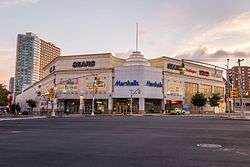
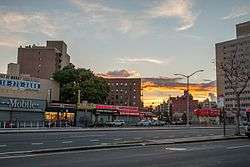
Rego Park is home to some of Queens' most popular shopping destinations, including the 277,000-square-foot (25,700 m2), 4-floor Rego Center. Phase I has a large Sears, Bed Bath & Beyond, Marshalls, Burlington Coat Factory, and Old Navy locations,[10] as well as a multilevel parking garage developed by Vornado Realty Trust. Phase II opened in 2010[13] with 950,000 square feet (88,000 m2) of retail space[14] on 62nd Drive across from Rego Park Center. It houses Kohl's, Century 21, Costco, T.J. Maxx, Toys "R" Us/Babies "R" Us, Payless ShoeSource, Panera Bread, and Pier 1 Imports, with more stores being built.[14]
Across the Long Island Expressway, in nearby Elmhurst, is the Queens Center Mall.[5] Queens Center opened on September 12, 1973, on land previously occupied by Fairyland,[15][16][17] a supermarket, and automobile parking. The mall doubled in size from 2002 to 2004.[5]
The first Trader Joe's in Queens opened in 2007 at 90-30 Metropolitan Avenue, in a building that also has a Staples and a Michaels,[18] and is next to a Sports Authority, Bob's Discount Furniture, and Home Depot.
The main business thoroughfare of Rego Park is 63rd Drive. The main section extends from Woodhaven Boulevard in the south, to Queens Boulevard in the north, with the central business district of Rego Park nestled between Alderton Street (just south of the Long Island Rail Road overpass), and Queens Boulevard. The stretch south of Alderton is entirely residential. The business district is anchored by The Rego Park School PS 139Q, an elementary school dating from 1928 and Our Saviour Lutheran Church established in 1926 which right across Wetherole Street from PS 139Q. The business district is criss-crossed by four side streets: Saunders, Booth, Wetherole, and Austin Streets. Most of the businesses lining 63rd Drive are the original single story "Taxpayers" dating from the 1930s.
Across Queens Boulevard to the north, 63rd Drive becomes 63rd Road, and its business district continues another three blocks; 63rd Drive actually shifts one block south of 63rd Road. There are many small businesses in this area. Shopping districts with many smaller stores, bakeries, pharmacies and restaurants can be found along 108th Street as well.[10]
Landmarks

The Lost Battalion Hall, on Queens Boulevard, derives its name from a World War I army unit that suffered many casualties. Now a community center, the structure was erected in 1939 as a hall for Veterans of Foreign Wars and American Legion. It was taken over as a community center by the New York City Department of Parks and Recreation in 1960, and is still operated as such.[19] While the VFW maintains its offices at the building, the American Legion left in 1962. The site also contains a play area and a New York City Department of Environmental Protection water pumping station.[5][20]
The Drake Theater, which opened in 1935 and closed in the 1990s, was used in the 1997 film Private Parts. The theater was damaged in December 1978 after around 500 people, complaining about the theater's sound system threw beer and liquor bottles at the screen and tearing holes in it, smashing seats and the candy counter with fire extinguishers from the walls, and breaking all the glass doors at the entrance.[5]
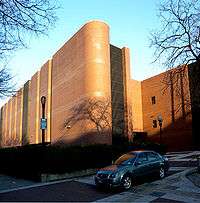
An AT&T telephone building exists at Queens Boulevard and 62nd Drive.[5]
Savior Lutheran Church, open since the 1920s, conducts its services in English and Chinese.[5]
The art deco Rego Park Jewish Center, opened in 1939, is notable for an A. Raymond Katz-designed façade with Old Testament scenes and symbols carved into it.[5] The building is listed on both the New York State and National Register of Historic Places.[21]
The Trylon Theater, an art deco theater built around the time of the 1939 New York World's Fair, was converted to the home of the Education Center for Russian Jewry in 2006. After local furor over interior refurbishment, the New York City Landmarks Preservation Commission was considering landmarking the property.[5] The theater, which closed in 2009, was repurposed into a synagogue for more than a decade, but in 2013, the synagogue's congregation objected to their new landlord's planned eviction of the synagogue. Largely composed of Russian Jews, the congregation had attempted, but failed, to buy the building in 2012.[22]
Notable roads
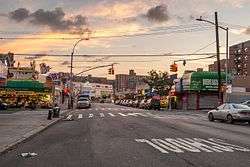
- 63rd Road and Drive, the commercial artery of Rego Park,[10] used to be Remsen’s Lane, which was named after the Remsen family who lived along the road.[5]
- The Crescents were originally composed of streets named Asquith, Boelsen, Cromwell, Dieterle, Elwell and Fitchett. These names were chosen when the Real Good Construction Company developed the area in the 1920s.[5]
- Horace Harding Expressway and Long Island Expressway was once a turnpike called Nassau Boulevard and went from Elmhurst to Flushing, Bayside, and Little Neck. It was renamed for Horace J. Harding (1863–1929), a finance magnate who directed the New York, New Haven and Hartford Railroad and the New York Municipal Railways System; Harding encouraged city planner Robert Moses's system of parkways on New York, and after Harding died, the boulevard—and later, service road to Interstate 495—was renamed after him.[23]
- Queens Boulevard, a wide at-grade highway that stretches from Long Island City to Jamaica, was formerly composed of two small dirt roads: Old Jamaica Road and Hoffman Boulevard. In the 1910s, it was paved and widened to 12 lanes. It is sometimes called the "Boulevard of Death" because of the high rate of pedestrian fatalities trying to cross the 12-lane boulevard.[9][24]
- Woodhaven Boulevard was known as Trotting Course Lane because it was named when horses were the main mode of transport. The lane dates back to the colonial days, and used to run along Whitepot's border Although it extends to Cross Bay Boulevard in the Rockaways, two small parts of the original lane still exist in Forest Hills.[25]
- Yellowstone Boulevard was one of a few colonial roads in the area. It was named after the area's original name.[5]
Community activism
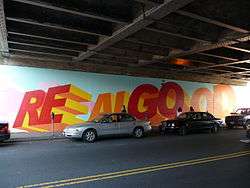
Rego Park Group, originally hosted on Yahoo! Groups, strived to improving the quality of life in the neighborhood.[26] The Rego Park Green Alliance has also been active in the community planting flowers and trees, arranging the installation of new garbage cans, pushing for the repair of some sidewalks and creating a large mural celebrating the neighborhood under the LIRR overpass on 63rd Drive.[27]
In March 2010, the Metropolitan Council on Jewish Poverty, a beneficiary agency of the UJA-Federation of New York, partnered with Masbia in the opening of a kosher soup kitchen on Queens Boulevard. As of August 2010, the free restaurant was serving over 1,500 meals per month to adults, senior citizens, and families.[28]
Friends of the Queensway is also another area organization. Its goal is to try to convert the abandoned Rockaway Beach rail line in Rego Park into a park, similar to the High Line in Manhattan. Proponents claim that converting the 3.5 miles (5.6 km) line to a rail trail stretching to Ozone Park would create parkland as well as a safe space to travel, in conformance with Mayor Bill de Blasio's Vision Zero traffic safety guidelines. However, opponents want rail service reinstated on the line.[9]
Public safety
The neighborhood is served by the New York City Police Department's 112th Precinct.[29] In 2014, the precinct had 7 rapes, 57 robberies, 60 felony assaults, 114 burglaries, 412 grand larcenies, and 102 grand larcenies auto. The total crime rate in 2014 was down almost 90 percent compared to in 1990.[30]
There is one engine and one ladder company in a single FDNY firehouse within its boundaries, and another on its border.[29]
Education
Public schools
Rego Park's public schools, as are the public schools in all of New York City, are operated by the New York City Department of Education. The following elementary schools serve Rego Park:
- P.S. 139 (Rego Park School, grades K-5)[31]
- P.S. 174 (William Sidney Mount School, grades K-6)[32]
- P.S. 175 (the Lynn Gross Discovery School, grades preK-5)[33]
- P.S. 206 (the Horace Harding School, grades K-5)[34]
- P.S. 220 (Edward Mandel School, grades preK-5)[35]
All areas in Rego Park are zoned to J.H.S. 157 Stephen A. Halsey (6-9), in Rego Park,[36] or J.H.S. 190 Russell Sage (7-9) in Forest Hills.[37] Rego Park is not zoned to a high school because all New York City high schools get students by application, though Forest Hills High School is located in nearby Forest Hills.
Private schools
Our Lady of the Angelus, a PK–8 private school operated by the Roman Catholic Diocese of Brooklyn, is located in Rego Park. Resurrection-Ascension School, another PK-8 private school operated by the Diocese of Brooklyn, is also located in Rego Park.
Private institutions include the Rego Park Jewish Center and the Jewish Institute of Queens (also known as the Queens Gymnasia).
Public libraries
The Rego Park Library Branch of Queens Library, is located at 91-41 63rd Drive in Rego Park.[38] As of 2010, the total annual circulation was 382,545 volumes, which is the highest number of volumes compared to two other libraries in Queens Community District 6, Forest Hills and North Forest Park libraries. All three libraries in Community Board 6 are heavily utilized by growing numbers of immigrants.[39]
Transportation
The Long Island Rail Road overpass between Austin and Alderton Streets was the location of the Rego Park station until its abandonment in 1962. Though physically part of the Main Line heading out to Jamaica and Ronkonkoma, the station operated as part of the Rockaway Beach Branch. The station was later dismantled, and little can be discerned of its existence now save for the flattened clearing beside the tracks.
The IND Queens Boulevard Line of the New York City Subway has local stations at 63rd Drive and 67th Avenue on the E M R trains.[40] The line, running under Queens Boulevard, dates from 1935-37.[41]
The Q38, Q59, and Q60 local buses serve the neighborhood, as do the QM10 and QM11 express buses.[42]
In popular culture
- Rego Park was the setting of the 1980s sitcom Dear John, which centered around the fictional "Rego Park Community Center."
- The CBS sitcom The King of Queens is set in Rego Park, and sometimes shows clips of the area.
- What Happened to Anna K.: A Novel by Irina Reyn is set in Rego Park. Most of the characters are Bukharan Jews who have emigrated from the Soviet Union.
- Brooklyn's Finest, a 2010 release, was filmed in part in Rego Park.
- A substantial part of Art Spiegelman's graphic novel Maus, a biographical account of his father, a Holocaust survivor, is set in Rego Park.
- The 2013 film The Wolf of Wall Street was filmed in part in Rego Park, at the Shalimar Diner.
- In an episode of General Hospital originally aired on May 26, 2015, Denise, an emerging character, claims that she's from Rego Park.
Notable residents
Notable current and former residents of Rego Park include:
- Sid Caesar (1922-2014), actor, comedian[43]
- Eddie Egan (1930-1995), New York City Police Department detective
- Vera-Ellen (1921-1981), actress and dancer
- Rosco Gordon (1928-2002), blues singer and songwriter[44]
- June Havoc (1912-2010), actress[45]
- Aram Haigaz (1900-1986), Armenian writer[46]
- Steve Hofstetter (born 1979), comedian, radio personality[47]
- August Howard (1910-1988), founder of the American Polar Society in 1934[48]
- Malika Kalontarova (born 1950), Central Asian dancer known as the "Queen of Eastern Dance" (People's Artist of USSR)[49]
- Fatima Kuinova, Central Asian singer, one of the leading singers in the Soviet Union (Merited Artist of USSR)[50]
- Gypsy Rose Lee, American burlesque entertainer
- Robert Lipsyte, sports journalist[51]
- Tommy Ramone, drummer of The Ramones
- Dave Rubinstein, singer of Reagan Youth
- Bobby Schayer, former drummer of Bad Religion
- Fred Silverman, television producer
- Art Spiegelman, Pulitzer Prize–winning graphic artist[52] who made Rego Park the setting for significant scenes involving his aged father in Maus, his graphic novel about the Holocaust
References
- ↑ Popik, Barry (1931-10-17). "The Big Apple: Buharlem or Bukharlem (Bukhara + Harlem)". The Big Apple. Retrieved 2015-08-18.
- 1 2 Table PL-P5 NTA: Total Population and Persons Per Acre - New York City Neighborhood Tabulation Areas*, 2010, Population Division - New York City Department of City Planning, February 2012. Accessed June 16, 2016.
- 1 2 Table PL-P3A NTA: Total Population by Mutually Exclusive Race and Hispanic Origin - New York City Neighborhood Tabulation Areas*, 2010, Population Division - New York City Department of City Planning, March 29, 2011. Accessed June 14, 2016.
- ↑ Queens Community Boards, New York City. Accessed September 3, 2007.
- 1 2 3 4 5 6 7 8 9 10 11 12 13 14 15 16 17 18 19 20 Wilkinson, Christina; Walsh, Kevin (5 March 2006). "REGO PARK, Queens". Forgotten NY. Retrieved 18 August 2015.
- 1 2 "The New York Times: Sunday March 9, 1930". NYTimes.com. 1930-03-09. Retrieved 2016-07-11.
- ↑ Jackson, Kenneth T., ed. (1995), The Encyclopedia of New York City, New Haven: Yale University Press, ISBN 0300055366
- 1 2 "Tale of 2 Libraries: Rego Park Edition". Rego-Forest Preservation Council. 2004-02-26. Retrieved 2015-08-18.
- 1 2 3 4 5 Laterman, Kaya (2015-02-05). "New Residences, Proposed QueensWay Advance in Rego Park, Queens". Wall Street Journal. Retrieved 2015-08-18.
- 1 2 3 4 5 6 7 8 Lisa Fraser (5 November 2014). "City Living: Rego Park is as Queens as it gets". AM New York. Retrieved 18 August 2015.
- ↑ http://www.clrsearch.com/Rego-Park-Demographics/NY/Household-Income?compare=11374
- ↑ Mooney, Jake (2006-03-19). "The True Story of the 'Fedders' Curse". The New York Times. Retrieved 2015-08-18.
- ↑ Kadinsky, Sergey (4 March 2010). "Rego Center II anchors open to fanfare". Queens Chronicle. Retrieved 2010-03-15.
- 1 2 "Rego Center, NY-Vornado Retail". Retrieved 2010-03-15
|first1=missing|last1=in Authors list (help) - ↑ Coangelo, Lisa L. (18 February 2015). "Bringing the magic of Queens long-gone amusement parks back to life". New York Daily News. Retrieved 14 June 2015.
- ↑ "Fairyland Park, Elmhurst". Queens Chronicle. Retrieved 2 June 2015.
- ↑ Lorraine Sciulli (27 November 2009). "Return to Fairyland". Juniper Park Civic Association. Retrieved 14 June 2015.
- ↑ "Trader Joe's is coming to Queens". New York Daily News. October 24, 2007. Retrieved February 15, 2013.
- ↑ Lost Battalion Hall Recreation Center
- ↑ "Museums with Lost Battalion Info". The Lost Battalion of WWI. 2002-08-02. Retrieved 2015-08-18.
- ↑ "Conservancy holds exclusive tour of historic Queens Synagogues", New York Landmarks Conservancy website. Accessed April 2, 2010.
- ↑ Colangelo, Lisa L. (2013-08-02). "An unsure future for the Trylon Theater and Rego Park synagogue". NY Daily News. Retrieved 2015-08-18.
- ↑ Walsh, Kevin (November 2013). "NYC STREETS FEATURING FULL NAMES". Forgotten NY. Retrieved 14 June 2015.
- ↑ Walsh, Kevin (June 2002). "ELMHURST, Queens". Forgotten NY. Retrieved June 8, 2015.
- ↑
- Walsh, Kevin (May 1999). "WOODHAVEN TROTTING COURSE". Forgotten NY. Retrieved June 13, 2015.
- Walsh, Kevin (November 2013). "TROTTING COURSE LANE, Forest Hills". Forgotten NY. Retrieved June 14, 2015.
- ↑ Original "Rego Park Group" on Yahoo Groups
- ↑ Rego Park Green Alliance
- ↑ "Masbia Serves Good Meals With Dignity". United Jewish Federation of New York. 3 August 2010. Retrieved 31 July 2011.
- 1 2 "Publications — New York City Department of City Planning" (PDF). New York City Department of City Planning. July 2009. pp. 105–106. Archived from the original (PDF) on July 2009. Retrieved 2010-09-19.
- ↑ http://www.nyc.gov/html/nypd/downloads/pdf/crime_statistics/cs-en-us-112pct.pdf
- ↑ http://schools.nyc.gov/SchoolPortals/28/Q139/
- ↑ http://schools.nyc.gov/SchoolPortals/28/Q174/
- ↑ http://schools.nyc.gov/SchoolPortals/28/Q175/
- ↑ http://schools.nyc.gov/SchoolPortals/28/Q206/
- ↑ http://schools.nyc.gov/SchoolPortals/28/Q220/
- ↑ http://schools.nyc.gov/OurSchools/Region3/Q157/default.htm?searchType=school
- ↑ http://schools.nyc.gov/OurSchools/Region3/Q190/default.htm?searchType=school
- ↑ "Queens Library". Retrieved 2010-09-19.
- ↑ "Community District Needs, Queens — Fiscal Year 2010" (PDF). Retrieved 2010-09-19.
- ↑ "Subway Map" (PDF). Metropolitan Transportation Authority. November 2016. Retrieved November 7, 2016.
- ↑ "PWA Party Views New Subway Link: Queens Section to Be Opened Tomorrow Is Inspected by Tuttle and Others". nytimes.com. The New York Times. December 30, 1936. Retrieved 27 June 2015.
- ↑ Queens Bus Map, Metropolitan Transportation Authority. Retrieved August 18, 2015.
- ↑ Bashinsky, uth. "REGO PARK'S IN TIME OF TRANSITION Growing biz & diversity", New York Daily News, August 18, 2002. Accessed July 1, 2016. " Rego Park also has been the home of many famous faces, including comedian Sid Caesar, who lived at 98-10 64th Ave. (the Walden Terrace apartment development)"
- ↑ Staff. "Rosco Gordon, 74, Blues Singer Who Influenced Rock and Reggae", The New York Times, July 22, 2002. Accessed July 11, 2016. "Rosco Gordon, a rhythm-and-blues singer and piano player from Memphis who influenced rock 'n' roll and reggae, died on July 11 at his home in Rego Park, Queens."
- ↑ Healion, James V. "At her 'end of the Rainbow' home, June Havoc recalls a bitter past", UPI, December 9, 1980. Accessed July 11, 2016. "Her mother once introduced herself and June Havoc to a gangster after a dawn delivery of stolen furniture to her Rego Park, N.Y., apartment saying, 'I am the mother of Gypsy Rose Lee. And this is my baby. She used to be somebody.'"
- ↑ Staff. "Aram Haigaz Chekenian, 85, Author of Books in Armenian", The New York Times, March 13, 1986. Accessed July 11, 2016. "Aram Haigaz Chekenian, who wrote hundreds of short stories, essays and poems, all in Armenian, died Monday in Booth Memorial Hospital in Flushing, Queens. He was 85 years old and lived in Rego Park."
- ↑ Silverberg, Alex. "Comic Thanks His Queens Upbringing", copy of article from The Queens Tribune, July 6, 2007. Accessed October 18, 2007. "Hofstetter has been all around Queens. He spent his younger years in Briarwood before moving on to Forest Hills, and finally settling down in Rego Park for the duration of his teen years."
- ↑ Browne, Malcolm W. "August Howard, 78, Organizer Of a Society for Polar Explorers", The New York Times, December 7, 1988. Accessed July 11, 2016. "August Howard, founder of the American Polar Society and the editor of a newsletter for polar explorers and researchers, died of heart disease Sunday. He was 78 years old and lived in Rego Park, Queens."
- ↑ "Ethnically Diverse Queens". askanewyorker.com.
- ↑ http://arts.endow.gov/honors/heritage/fellows/fellow.php?id=1992_08
- ↑ Lipsyte, Robert. "COPING; My Bullied Days: A Smart Fat Kid's Story", The New York Times, October 22, 1995. Accessed October 11, 2007. "Rego Park was predominately Jewish, and most of the bullying had no ethnic edge."
- ↑ Of mice and men, The Age, March 27, 2004.
External links
| Wikimedia Commons has media related to Rego Park, Queens. |
- Rego Park, NY History
- Queens Community District 6 - New York City Department of City Planning
- The Parks of Rego Park


